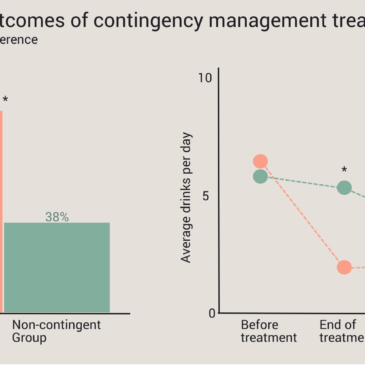Contingency management is an approach to substance use treatment that involves repeatedly testing a client to see if they have used the target substance recently, and giving them a reward or incentive each time the test shows that they have been abstinent. Studies have shown that contingency management is effective for treating Alcohol Use Disorder (AUD), and that it works best when the reward is provided immediately after testing. It can be logistically difficult to implement this type of treatment approach, because it requires frequent check-ins with clients every day for weeks or even months. However, with today’s technology it is easier to communicate with, test, and reward participants remotely and instantaneously. This week, The DRAM reviews a study by Mikhail Koffarnus and colleagues that tested the feasibility and efficacy of a remotely-delivered contingency management treatment for AUD.
What was the research question?
Is this remotely delivered monetary incentive contingency management program feasible and efficacious for promoting abstinence among people with AUD?
What did the researchers do?
In the main part of the study, forty participants were randomized into two groups – contingent and non-contingent. Participants in both groups answered questions about their alcohol use by text message every day. They also received a special breathalyzer and were asked to submit breath test results three times a day for three weeks. For every breath result submitted, each participant received a $1 payment immediately. For participants in the contingent group, each day that they submitted three negative1 results, they received an additional payment that started at $5 that increased for every day that they were abstinent. Participants in the non-contingent group were matched to a person in the contingent group and received the same payments that their partner did, regardless of their own breathalyzer results. Finally, the researchers followed-up with the participants a month after the treatment ended to assess their drinking habits.
What did they find?
Overall, participants responded to 96% of the scheduled breathalyzer tests over the course of the study, indicating that the treatment was easy for them to adhere to. Based on their breathalyzer results, participants in the contingent group were abstinent from alcohol on 85% of the days during the treatment phase, compared to only 38% in the non-contingent group (see figure). The text messages revealed that during the treatment phase, and through the one-month follow-up, the contingent group experienced a statistically significant decrease in the number of drinks they consumed per day in comparison to the non-contingent group.
Figure: The graphs illustrate the differences in drinking behavior between the two groups. Click image to enlarge.
Why do these findings matter?
These findings suggest that remotely-delivered contingency management treatment programs are feasible and can successfully reduce alcohol consumption for people with AUD. Healthcare providers who treat people with AUD might want to consider implementing such a treatment program for their patients.
Every study has limitations. What are the limitations in this study?
Participants were prompted for breathalyzer result submissions at the same time every day. Because breathalyzer tests can only detect recent alcohol use, it might have been possible for some participants to drink alcohol between tests without being detected. Repeating this pilot study with more participants will allow us to be more confident in the generalizability of these results.
For more information:
Are you concerned about your drinking patterns? You can find information and self-help resources online at the NIH’s Rethinking Drinking website.
— Rhiannon Chou Wiley
What do you think? Please use the comment link below to provide feedback on this article.
1. That is, a result indicating the participant had not consumed alcohol recently.






Rohini April 30, 2019
What kind of technology is required to administer this remote contingency management treatment? How do you monitor client adherence to participation and abstinence. How do you detect misuse?
Rhiannon Wiley April 30, 2019
Thank you for your question. The authors of this study indicated that they used the Soberlink SL2 breathalyzer device for the biochemical verification of alcohol abstinence in this study, accompanied by text-message ecological momentary assessments of self-reported drinking behavior. Participants were paid with deposits to reloadable debit cards. Client adherence to participation and abstinence was measured by their responses to the text-message EMA questions and their submissions of breathalyzer results within a particular time frame each day. The Soberlink breathalyzer device photographed the participant during the breath assessment and used facial recognition technology to compare this with a reference picture of the participant to ensure the identity of the individual providing the breath sample. In instances where the facial recognition technology could not verify the identity of the person providing the breath sample, the photograph was sent to the research team, and they verified the individual’s identity based on reference photos.